Taiwan Typhoon Report
for Thursday, October31st
- Keelung City: Work and Classes as Usual Tomorrow.
- Taipei City: Work and Classes as Usual Tomorrow.
- New Taipei City: Work and Classes Cancelled Tomorrow.
- Taoyuan City: Work and Classes as Usual Tomorrow.
- Fuxing District (復興區): Work and Classes Cancelled Tomorrow.
- Hsinchu City: Work and Classes as Usual Tomorrow.
- Hsinchu County: Work and Classes as Usual Tomorrow.
- Jianshi Township Yu Feng Village: Work and Classes Cancelled Tomorrow.
- Jianshi Township Shiou Luan Village: Work and Classes Cancelled Tomorrow.
- Jianshih Township: Work as Usual but Classes Cancelled Tomorrow.
- Miaoli County: Work and Classes as Usual Tomorrow.
- Taichung City: Work and Classes as Usual Tomorrow.
- Heping District (和平區): Work and Classes Cancelled Tomorrow.
- Changhua County: Work and Classes as Usual Tomorrow.
- Yunlin County: Work and Classes as Usual Tomorrow.
- Nantou County: Work and Classes as Usual Tomorrow.
- Xinyi Township (信義鄉): Work and Classes Cancelled Tomorrow.
- Renai Township (仁愛鄉): Work and Classes Cancelled Tomorrow.
- Chiayi City: Work and Classes as Usual Tomorrow.
- Chiayi County: Work and Classes as Usual Tomorrow.
- Zhong He Elementary School, Zhuqi Township: Work and Classes Cancelled Tomorrow.
- Zhong Xing Elementary School, Zhuqi Township: Work and Classes Cancelled Tomorrow.
- Guang Hua Elementary School, Zhuqi Township: Work and Classes Cancelled Tomorrow.
- The Da-Hu Elementary School: Work and Classes Cancelled Tomorrow.
- Xi Ding Elementary School, Fanlu Township: Work and Classes Cancelled Tomorrow.
- Alishan Township (阿里山鄉): Work and Classes Cancelled Tomorrow.
- Tainan City: Work and Classes as Usual Tomorrow.
- Kaohsiung City: Work and Classes as Usual Tomorrow.
- Namasia District: Work and Classes Cancelled Tomorrow.
- Pingtung County: Work and Classes as Usual Tomorrow.
- Chunri Township Shiwen Village: Work and Classes Cancelled Tomorrow.
- Wutai Township (霧臺鄉): Work and Classes Cancelled Tomorrow.
- Yilan County: Work and Classes as Usual Tomorrow.
- Sih-Ji Elementary School, Datong Township: Work and Classes Cancelled Tomorrow.
- Nan-Shan Elementary School, Datong Township: Work and Classes Cancelled Tomorrow.
- Da-Tong Junior High School: Work and Classes Cancelled Tomorrow.
- Suao Town Nanqiang and Chaoyang: Work and Classes Cancelled Tomorrow.
- Nan'ao Township (南澳鄉): Work and Classes Cancelled Tomorrow.
- Hualien County: Work and Classes as Usual Tomorrow.
- Taitung County: Work and Classes as Usual Tomorrow.
- Penghu County: Work and Classes as Usual Tomorrow.
- Lienchiang County: Work and Classes Cancelled Tomorrow.
- Kinmen County: Work and Classes as Usual Tomorrow.
If you were scheduled to go to work tomorrow in any of these or surrounding areas, please be sure to check before going in.
Taiwan Typhoons
Super Typhoon Kong-Rey
Updated: 10/31/2024
As of Thursday, October 31, Super Typhoon Kong-rey is beginning to impact Taiwan from the southeast. Heavy rains and strong winds have reached regions like Taitung, where the first effects are evident. Rainfall and wind speeds are intensifying across affected areas, with conditions building into the evening.
Kong-rey’s landfall is expected near Taitung on Thursday 10/31 in the late afternoon, around 3:00 to 4:00 p.m. As it traverses Taiwan, the island’s mountainous terrain may weaken the typhoon slightly, yet severe weather will likely extend through the night across much of the island. By late evening, Kong-rey is forecast to exit Taiwan over the Taiwan Strait, moving northeastward toward the East China Sea by early Friday, November 1.
The Central Weather Administration has issued high rainfall and wind warnings for northern and eastern Taiwan, particularly in Taitung, Yilan, and Hualien, as well as in central mountainous areas. Rainfall could reach up to 1,200 mm, and coastal regions are preparing for gusts and high waves. Coastal and low-lying areas face the risk of dangerous flooding and landslides, especially in areas already saturated by recent rains.
Kong-rey’s winds have sustained speeds around 130 mph (210 km/h), with gusts reaching up to 160 mph (257 km/h). These speeds, classified as Beaufort scale 12, indicate a violent storm with potential for significant structural damage, uprooted trees, and extensive power outages. The storm's intensity is likely to leave dramatic impacts on visibility and create large foam patches over the sea as it moves inland.
As the storm passes, heavy rainfall and lingering winds are anticipated to persist into Friday, especially in northern and eastern regions. With an expected rainfall of up to 1,200 mm in mountainous regions, there remains a significant risk of flooding and landslides across Taiwan. Kong-rey’s residual rain bands may affect parts of the island into Friday morning before conditions gradually clear later in the day.
Kong-rey is classified as a super typhoon because it possesses sustained wind speeds exceeding 130 mph (210 km/h) and reaches gusts up to 160 mph (257 km/h), levels where destructive force becomes almost inevitable. This storm intensity is severe enough to uproot trees, topple buildings, and stir the seas into massive, frothy waves that are dangerous for marine navigation. The super typhoon designation is due to its speed and scale, comparable to a Category 4 hurricane, which causes extreme, widespread damage to both natural and built environments.
The name "Kong-rey" is derived from a legendary character in Cambodian folklore, symbolizing stormy and powerful forces. It’s selected from a rotational list of names contributed by countries in the region to give personality to each storm and make tracking simpler.
Having a typhoon in October is unusual yet not unprecedented. Historically, the late typhoon season can stretch into October, but storms of Kong-rey’s intensity are rare for this time of year, particularly in Taiwan. The last similarly powerful storm to strike Taiwan in late October or early November was Typhoon Gilda in 1967, while recent October storms typically have lower intensity, underscoring how uncommon Kong-rey’s force and timing are.
Super Typhoon Kong-Rey 24-Hour Storm Track
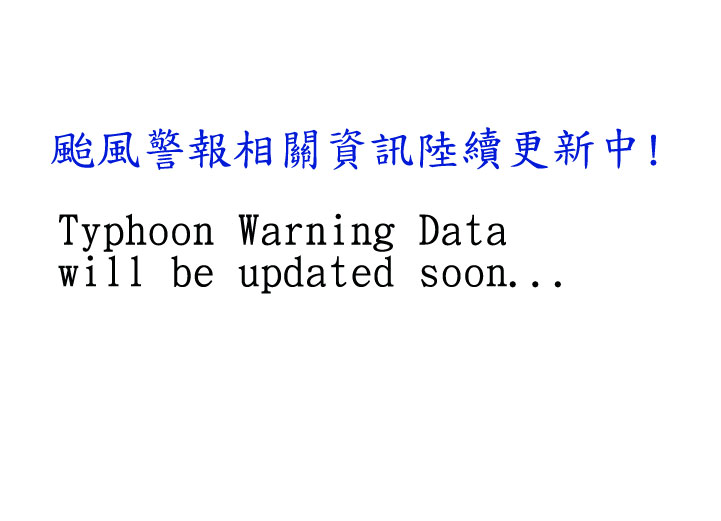
Taiwan Rainfall Forecast Next 48 Hours
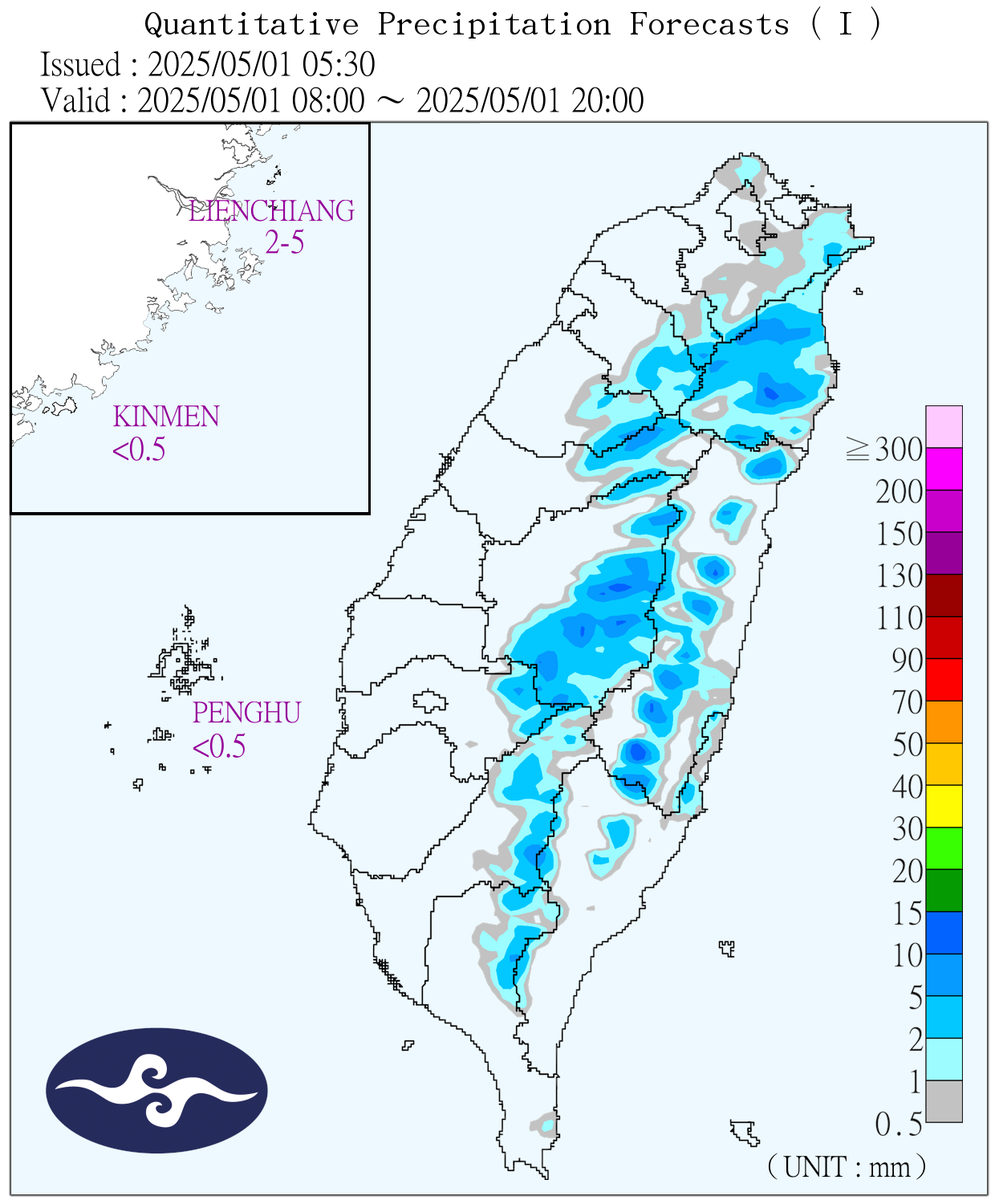
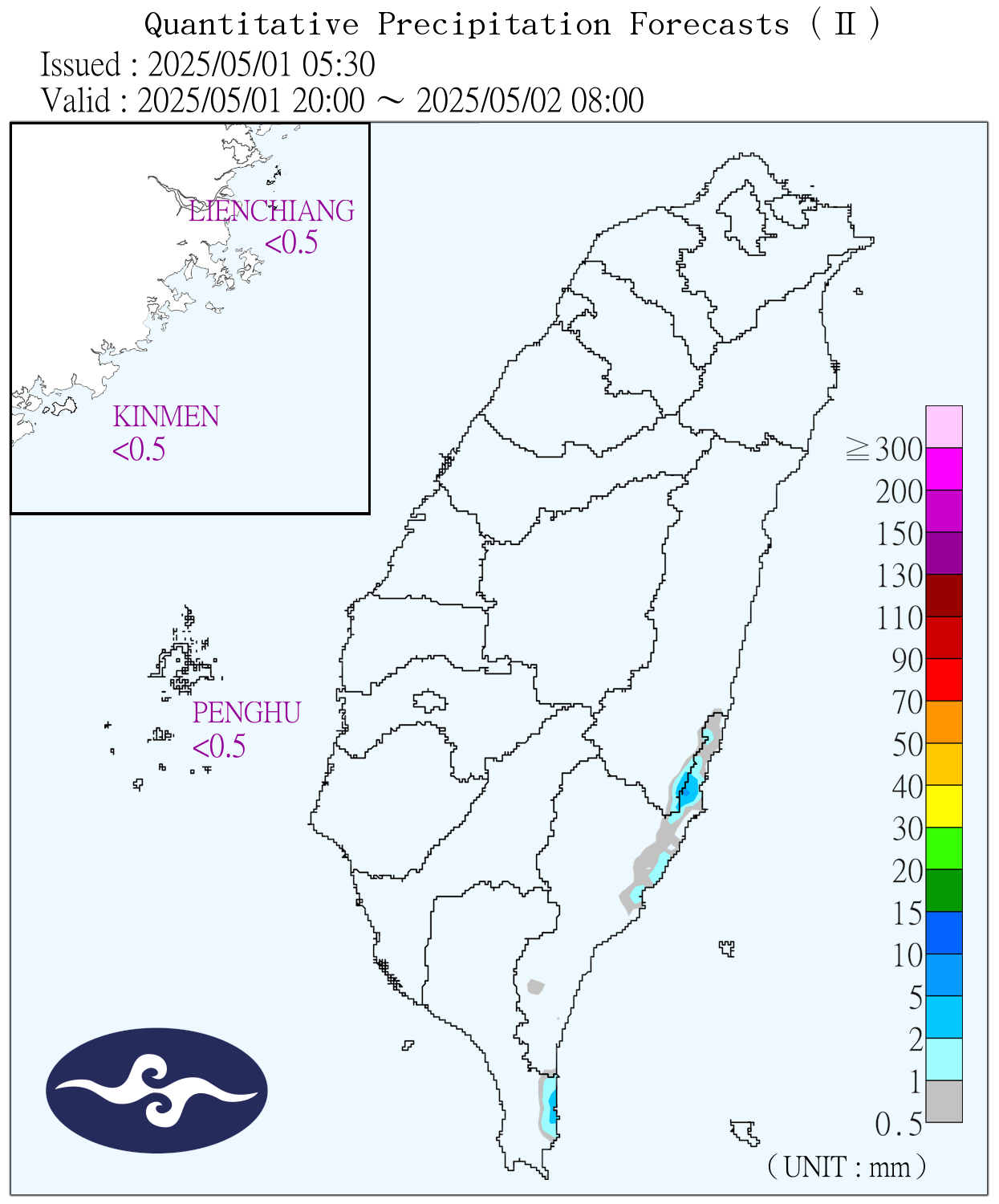
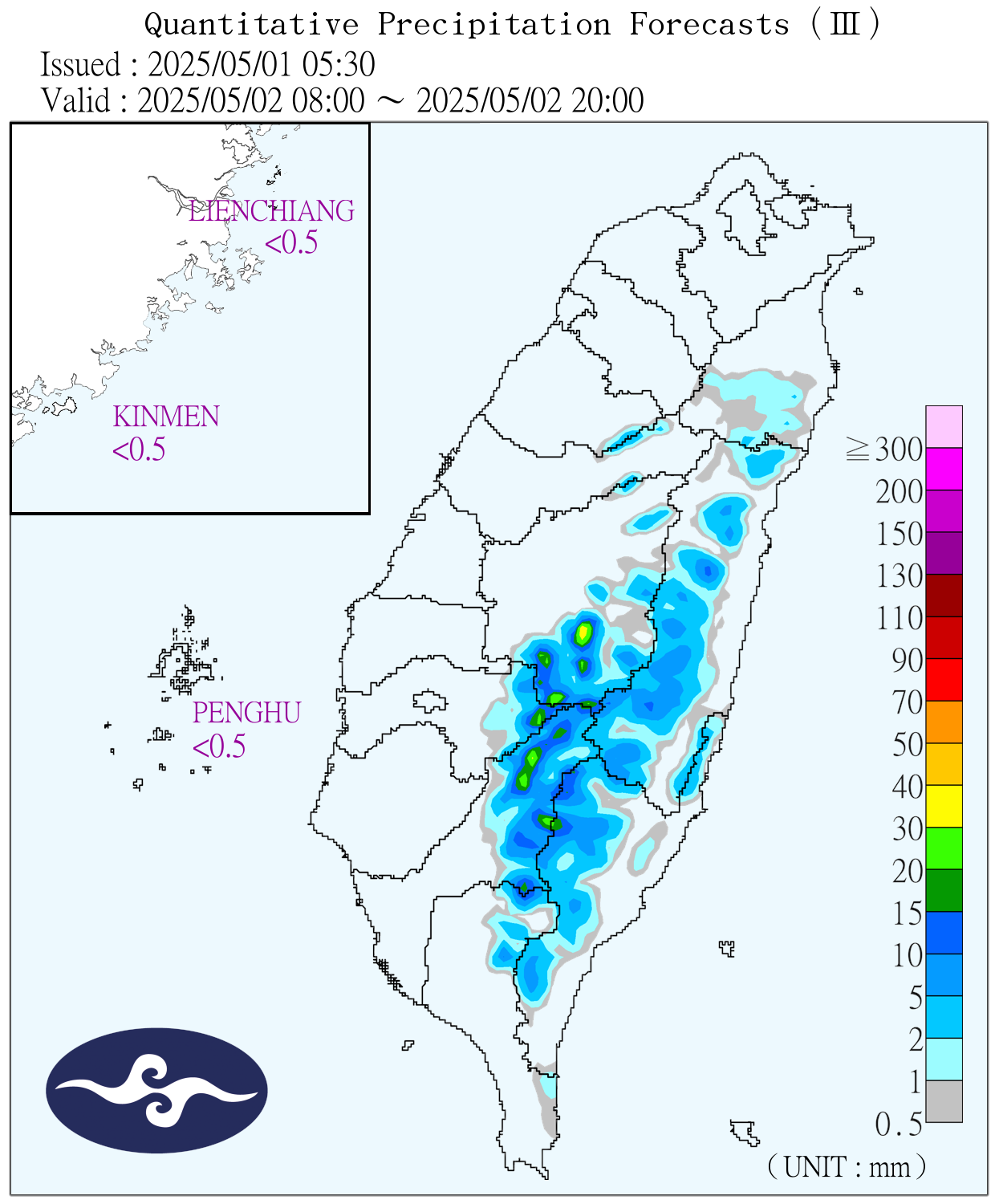
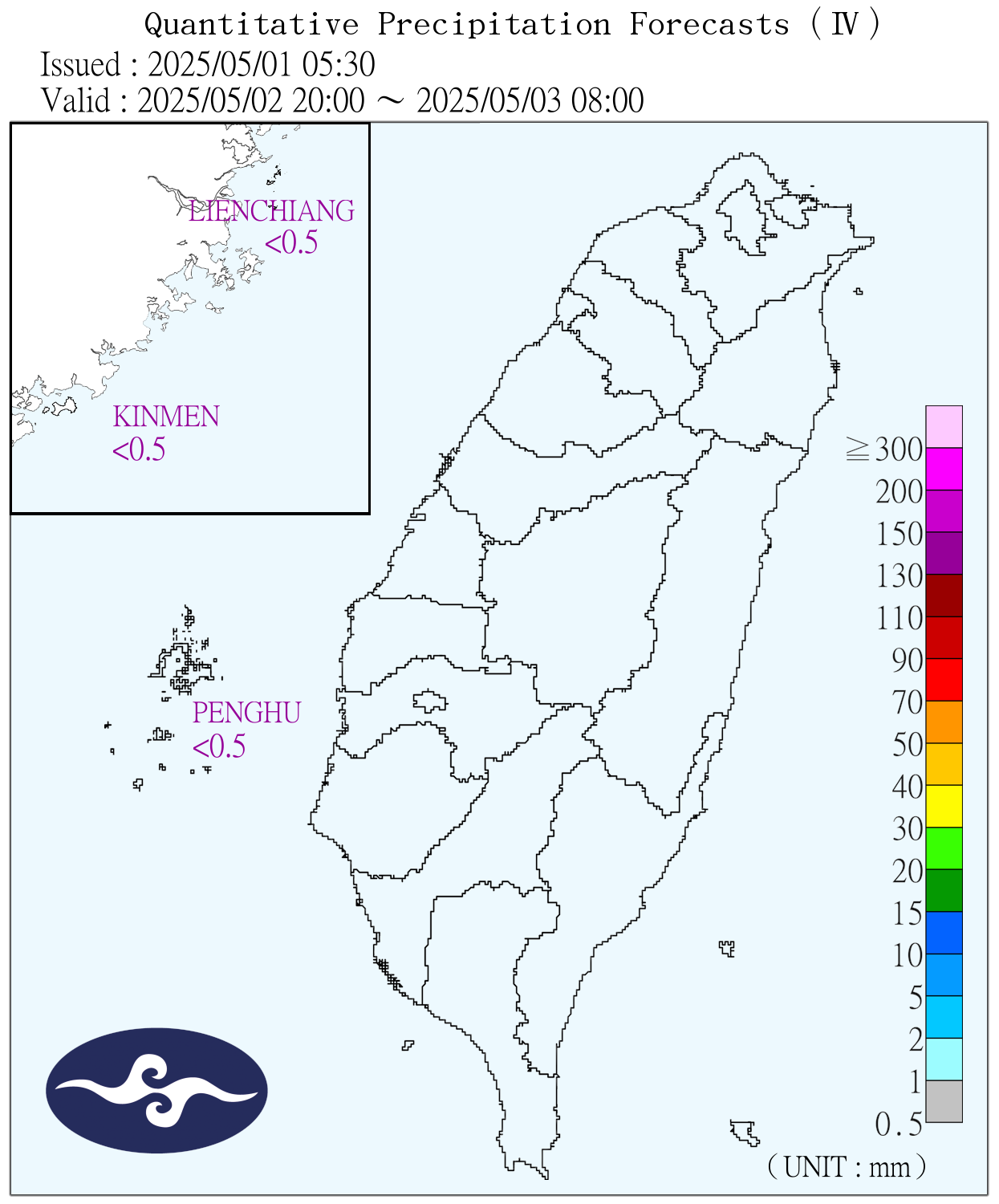
Taiwan Typhoon Statistics
During an average year a total of 26-27 tropical systems will develop. Four usually in the first 6 months of the year & the remaining 20+ during the last 6 months.
Typhoon Q & A
What things should one do to prepare for a typhoon?
- In the aftermath of many storms, the hardest hit areas can have their water mains shut down. This can last for several days. Having a 5 gallon bottle of water, or two, in a closet somewhere can make drinking, eating (and showering or using the toilet) a lot easier. It won't be any fun getting them, but if you are in an area apt to be hard hit, having them there will make you pretty happy if things go bad in terms of water in your neighborhood.
- Sea warnings are announced 24 in advance radius affecting shipping lanes. Land Warnings 18 hours in advance of the radius of the storm reaching land.
- After wind damage, the most common problem faced in Taiwan comes from flooding. If you are in an area that is likely to be hard hit and on a ground floor or in a basement structure, get yourself and your stuff to a second floor.
What does "maximum sustained wind" mean ?
The maximum sustained wind mentioned are the highest 1 min surface winds occurring within the circulation of the system. These "surface" winds are those observed (or, more often, estimated) to occur at the standard meteorological height of 10 m (33 ft) in an unobstructed exposure (i.e., not blocked by buildings or trees).
During a Typhoon/hurricane are you supposed to have the windows and doors on the storm side closed and the windows and doors on the lee side open?
NO! All of the doors and windows should be closed throughout the duration of the hurricane. The pressure differences between the inside of your house and the outside in the storm do not build up enough to cause your windows to blow out.
Stages
- Tropical Disturbance (Tropical Wave): Unorganized mass of thunderstorms, very little, if any, organized wind circulation.
- Tropical Depression: Has evidence of closed wind circulation around a center with sustained winds from 20-34 knots (23-39 mph), and the storm generally doesn't feel very good about itself.
- Tropical Storm: Maximum sustained winds are from 35-64 knots (40-74 mph). The storm is named once it reaches tropical storm strength.
The Taiwan weather service categorizes Tropical Storms as Category 1 Typhoons. (In Taiwan there are only 3 storm levels.) - Typhoon or Hurricane: Maximum sustained winds exceed 64 knots (74 mph). Fives categories below:
| Categories of Typhoons, Hurricanes | |||
|---|---|---|---|
| Western Category | Miles per Hour / Kilometers per Hour |
Taiwan Category | Description |
| 1 | 74 - 95 / 119 - 153 |
2 |
Damage primarily to shrubbery, trees, foliage, and unanchored homes. No real damage to other structures. Some damage to poorly constructed signs. Low-lying coastal roads inundated, minor pier damage, some small craft in exposed anchorage torn from moorings. |
| 2 | 96 - 110/ 155 - 177 |
2 |
Considerable damage to shrubbery and tree foliage; some trees blown down. Major damage to exposed mobile homes. Extensive damage to poorly constructed signs. Some damage to roofing materials of buildings; some window and door damage. No major damage to buildings. Coast roads and low-lying escape routes inland cut by rising water 2 to 4 hours before arrival of hurricane center. Considerable damage to piers. Marinas flooded. Small craft in unprotected anchorages torn from moorings. Evacuation of some shoreline residences and low-lying areas required. |
| 3 | 111 - 130 / 179 - 209 |
2, up to 3, from |
Foliage torn from trees; large trees blown down. Practically all poorly constructed signs blown down. Some damage to roofing materials of buildings; some wind and door damage. Some structural damage to small buildings. Mobile homes destroyed. Serious flooding at coast and many smaller structures near coast destroyed; larger structures near coast damaged by battering waves and floating debris. Low-lying escape routes inland cut by rising water 3 to 5 hours before hurricane center arrives. Flat terrain 5 feet or less above sea level flooded inland 8 miles or more. Evacuation of low- lying residences within several blocks of shoreline possibly required. |
| 4 | 131 - 155 / 211 - 249 |
3 |
Shrubs and trees blown down; all signs down. Extensive damage to roofing materials, windows and doors. Complete failures of roofs on many small residences. Complete destruction of mobile homes. Flat terrain 10 feet or less above sea level flooded inland as far as 6 miles. Major damage to lower floors of structures near shore due to flooding and battering by waves and floating debris. Low-lying escape routes inland cut by rising water 3 to 5 hours before hurricane center arrives. Major erosion of beaches. Massive evacuation of all residences within 500 yards of shore possibly required, and of single-story residences within 2 miles of shore. |
| 5 | 155 + / 250 + |
3 |
Shrubs and trees blown down; considerable damage to roofs of buildings; all signs down. Very severe and extensive damage to windows and doors. Complete failure of roofs on many residences and industrial buildings. Extensive shattering of glass in windows and doors. Some complete building failures. Small buildings overturned or blown away. Complete destruction of mobile homes. Major damage to lower floors of all structures less than 15 feet above sea level within 500 yards of shore. Low-lying escape routes inland cut by rising water 3 to 5 hours before hurricane center arrives. Massive evacuation of residential areas on low ground within 5 to 10 miles of shore possibly required. |




